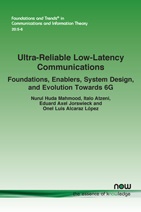Ultra-Reliable Low-Latency Communications: Foundations, Enablers, System Design, and Evolution Towards 6G
By Nurul Huda Mahmood, Centre for Wireless Communications, University of Oulu, Finland, nurulhuda.mahmood@oulu.fi | Italo Atzeni, Centre for Wireless Communications, University of Oulu, Finland, italo.atzeni@oulu.fi | Eduard Axel Jorswieck, Institute for Communications Technology, Technische Universität Braunschweig, Germany, e.jorswieck@tu-bs.de | Onel Luis Alcaraz López, Centre for Wireless Communications, University of Oulu, Finland, onel.alcarazlopez@oulu.fi
Abstract
Wireless communication has traditionally been designed to connect human users. The main design goal was to maximize the data rate while guaranteeing moderate reliability and latency targets dictated by the limitations of human senses. The application of wireless connectivity for machine to machine communications, typically known as machinetype communications (MTC), has been growing in the past decade due to its flexibility, scalability and ease of use. It is also driven by the proliferation of Internet of Things (IoT) nodes and applications, with several billions of connected devices expected by the next decade.
The fifth-generation (5G) New Radio (NR) wireless system has introduced two distinct services classes to support MTC, namely massive machine-type communications (mMTC) and the ultra-reliable low-latency communications (URLLC). Out of these, designing URLLC solutions is the most challenging given that it aims to provide dependable connectivity for mission-critical applications in industrial scenarios, process engineering and other similar verticals.
URLLC aims to guarantee very high reliability and very low latency, and therefore the outage performance replaces the average performance as the main design criterion. This calls for a new approach to the communication- and information-theoretic fundamentals of wireless system design. Different theoretic foundations of URLLC have so far been treated in individual and disconnected works that fail to provide a meta-level understanding of this topic. This monograph aims at filling this gap by presenting a comprehensive coverage of the topic including the motivation, theory, practical enablers and future evolution. The unified level of details in this monograph is aimed at providing a balanced coverage between its fundamental communication- and information-theoretic background and its practical enablers, including 5G NR system design aspects. Finally, this monograph offers an outlook on URLLC evolution in the sixth-generation (6G) era towards dependable and resilient wireless communications.
Ultra-Reliable Low-Latency Communications: Foundations, Enablers, System Design, and Evolution Towards 6G
Ultra-Reliable Low-Latency Communications (URLLC) was introduced into 5G networks to facilitate machine to machine communication for such applications as the Internet of Things. But designing URLLC systems, with disjointed treatment of the topic in the literature, has proven challenging.
In this work, the authors present a comprehensive coverage of the URLLC including the motivation, theory, practical enablers and future evolution. The unified level of details provides a balanced coverage between its fundamental communication- and information theoretic background and its practical enablers, including 5G system design aspects. The authors conclude by offering an outlook on URLLC evolution in the sixth-generation (6G) era towards dependable and resilient wireless communications.
This is the first book to give the reader a complete, yet concise, introduction to the theoretical and application oriented aspects of a topic at the core of both 5G and 6G wireless communication systems. As such, it is essential reading for designers and students of such systems.
